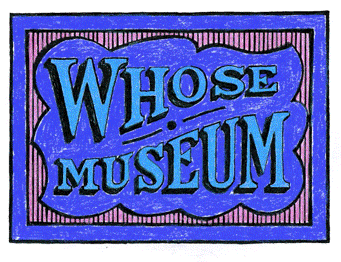Anonymous Donor, Untitled (I hate forms!), 2009, Pastel on paper, 24.5 x 14 cm
Whose Museum Collection (WM2009.032)
When and why did you start working with participatory art? Was it out of your own need, on your own initiative or through an invitation, assignment or other reason?
Whose Museum started in Vancouver in 2008. It has been collaborative from the start. Our aim has not been to perform participatory art. Whose Museum has always been interested in the ethos of collective feminist art practices, the chance energy around fluxus happenings, and artist collectives like N.E. Thing Co., Group Material, Image Bank, and General Idea. Those ways of working collectively are not limited to the contemporary understanding of participatory art which often amounts to a spectacle or moralistic debate. To begin with we were a bunch of weirdos trying to bring people, places, and objects together. We grew to be a collective with many artists involved. One of the earliest Whose Museum Associates was a clown, Dr. Storey, who invited people to give us things for the collection of Whose Museum. Objects and drawings stuck to us. We kept track of these things by accessioning them all equally without classifications. Over the years we exhibited the collection in random bars, galleries, backyards, etc. We found that the exchange over these objects offered unexpected encounters that were important for us to unlearn our own expectations about art.
What do you believe are the artistic qualities of working with others?
When you think of working with others, what are you thinking of?
At Whose Museum, we often discuss how to make the conditions for art to happen. We do believe that there is value in the unprofessional and letting go of prescribed notions of art. When we worked together with Whose Museum Associate Patrick Cruz last year we also talked about this with him. He said that having faith in the unexpected is important for artists in order to manifest what they want to imbue or attract. On our podcast he also makes some great points about trust, psychic protection, aliens, and ghosts in our collection. He gave us a freestyle workshop that helped us to understand what he meant by trusting the unexpected. Starting from care and friendship, our exhibition with Cruz last year brought people together for art to happen, informing our work in ways which we could not have planned even if we’d tried.
The artist Wu Tsang also has an interesting perspective. That making art is an excuse to collaborate. She has spoken about her work as having a band: different people who come together to do things now and then. Whose Museum can relate to that.
How do you experience the conditions for your work with participatory art?
Over the years we have experienced being identified differently given the times, such as participatory, archival, inclusive, collective, social practice. This is one of the conditions making our work harder because labels lead people to presuppose they know what we are.
We are an art collective running an artist’s museum. This is not new: there is a long history of artist’s museums and collectives. Many times people aren’t aware of that, or they don’t recognise what we do as being art, because our perimetres are so blurry. They are blurry because we love playing with our rules.
We put things out there and see what comes back before reflecting more critically on what we’re doing. This way of working is not often rewarded in the arts today since artists are expected to defend every choice in their work before revealing it to the world. Sometimes for us it’s also hard to keep the faith in our own intuition in the face of the professional art world.
It can be nice when people don’t recognise it as art, but this depends on the setting. In an art context it can be disappointing when they don’t take the time to engage enough to understand the scope of the project, or see that it’s art, since the status quo is still often limited to what you find in white cube settings.
Do you enjoy participating in other people's art projects as an active audience? How does it make you feel?
Whose Museum Associate Anna Szaflarksi recently summed it up nicely on a T-shirt she made that said, “Please establish an emotional relationship with me.”
How do you assess whether a participatory project is successful or not? How does it feel when it is successful, what is the gain for you?
Our work is desirable for us when it emerges from communal joy. It ceases to be good when it starts to create pressure for its members. If we can negotiate making more and more organised projects with Whose Museum while at the same time preserving our mode and attitude, it will keep going.
Do you have a target group that you usually turn to or that you are more interested in working with? If you are addressing an inexperienced art audience, what is your drive to specifically work with them?
We just try to set things in motion and see what sticks, what comes back, who is drawn to it. We do not overly analyse this process, we roll with it. We don’t set out to work with target groups and we have no predetermined outcomes. Our collection helps to connect people, places, objects, and events. The happenstance relations that arise through these connections are what guide us.
What would you like to get out of a network and a platform for participatory art?
We would enjoy entering a conversation and contributing to a broader understanding of art outside of individual studio practice/white cube/academy/market/professionalised scenes.
Interview conducted in December, 2020
with Whose Museum Associates Laura VI-X Hatfield and Theresa Tbot Kampmeier
For more on Flock Projects:
